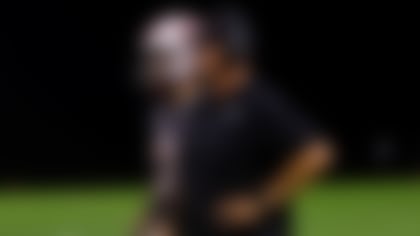The common denominator among the NFL's elite is the presence of a franchise quarterback under center. Teams with blue-chip signal-callers routinely find themselves in the Super Bowl hunt, while those without established QBs struggle to win consistently in an ultra-competitive league. Thus, executives search high and low for quarterbacks with the tools to transform a franchise into a winner.
Brooks: Draft grades
Bucky Brooks performs a division-by-division assessment of the draft, highlighting notable picks and handing out grades. **READ**
In the 2011 NFL Draft, several teams expended early selections on quarterback prospects hoping to land an upper-echelon playmaker with the goods to lead a postseason run. The Carolina Panthers (Cam Newton), Cincinnati Bengals (Andy Dalton) and San Francisco 49ers (Colin Kaepernick) all remain pretty satisfied with their returns, having all participated in last season's playoffs. While the jury is still out on the Tennessee Titans' pick (Jake Locker), the Jacksonville Jaguars (Blaine Gabbert) and Minnesota Vikings (Christian Ponder) simply failed to get it right on draft night.
In 2012, the Indianapolis Colts (Andrew Luck), Washington Redskins (Robert Griffin III) and Seattle Seahawks (Russell Wilson) found their franchise quarterbacks on draft weekend -- something that also might be true for the Miami Dolphins (Ryan Tannehill) and Philadelphia Eagles (Nick Foles). But the Cleveland Browns struck out, despite investing a first-round pick in a mature signal-caller (Brandon Weeden).
With the Jaguars, Vikings and Browns all readdressing the quarterback position in Round 1 of the 2014 draft, I thought I would take a closer look at each situation. Here are my thoughts:
Jacksonville Jaguars
What was the book on Blaine Gabbert heading into the 2011 draft? Gabbert ranked as the top quarterback in the 2011 class on several boards across the league. Teams were intrigued with his prototypical physical dimensions, arm talent and athleticism. In 26 starts for the Missouri Tigers, Gabbert completed more than 61 percent of his passes for 6,779 yards, posting a 40:18 touchdown-to-interception ratio. Although Gabbert's numbers paled in comparison to Chase Daniel's production guiding the same offense, Gabbert's raw tools convinced many that he could develop into an impact player in the pros.
Scouts did worry about Gabbert's pocket poise and deep-ball accuracy. He seemingly wilted under heavy pressure at Mizzou, exhibiting a lack of composure and courage when the pocket broke down. He routinely flinched with defenders in close proximity -- a tell-tale sign of a quarterback looking at the rush instead of focusing on his progressions down the field. Gabbert also struggled with his accuracy on throws beyond 15 yards; he couldn't consistently place the ball in the strike zone on deep in- or out-breaking routes. Thus, Gabbert compiled numbers by terrorizing opponents with a host of quick-rhythm throws (bubble screens, stick routes and quick outs).
Where did it go wrong in Jacksonville? Truthfully, Gabbert was destined to fail with the Jaguars. He didn't have a stellar supporting cast around him and he was thrown to the wolves before he was ready to play as a pro. Also, the 2011 NFL lockout prevented Gabbert from getting a jump-start on his career with offseason workouts and minicamps. He didn't have a solid grasp of the offense -- or the speed and pace of the NFL game -- prior to taking over as the Jaguars' starter in Week 3 of his rookie season. Lastly, the Jaguars didn't do Gabbert any favors by having three different offensive coordinators in his three seasons with the team. Sure, NFL quarterbacks are expected to be adaptable, but it's hard for any signal-caller to adjust to constant change in the play-calling department, particularly when it's a young QB still getting a feel for the pro game.
Now, I'm not trying to absolve Gabbert for his role in the Jaguars' underachievement over the last few years, but it's important to note that the team didn't put him in the best situation to succeed. In March, Jacksonville traded him to San Francisco for a sixth-round pick.
Why will it be different for Blake Bortles? In their second year with the franchise, general manager Dave Caldwell and head coach Gus Bradley are making a concerted effort to not repeat the mistakes of the prior regime. First and foremost, the Jaguars appear to have a plan in place to slowly bring along Bortles until he is ready to take over as the starter. The team re-signed Chad Henne to a two-year deal in March, providing a solid placeholder. Although Henne obviously will do his best to retain the starting position, I'm sure he has been encouraged to share his knowledge with the youngster in the meeting room. The seventh-year veteran should be a valuable mentor to Bortles while he adapts to the NFL.
Whenever Bortles is ready to take the reins, he will be surrounded by a number of enticing weapons acquired by the Jags this offseason. In free agency, Jacksonville scooped up promising RB Toby Gerhart. And in the draft, after selecting Bortles in Round 1, Jacksonville quickly grabbed a pair of intriguing pass catchers (Marqise Lee and Allen Robinson) in the second round. On Day 3 of the draft, the Jags added running back Storm Johnson, Bortles' backfield mate at Central Florida. Thus, Bortles won't feel the pressure of having to carry the entire offense on his back because he is supported by capable playmakers.
Bortles showed glimpses of being a big-time quarterback during his time at UCF, but he must continue to work on his judgment under duress, while developing a better feel for making full-field reads. At the end of the day, though, he has all of the physical tools and intangibles coaches look for in a franchise quarterback.
Cleveland Browns
Battista: The fall and rise of Johnny

Judy Battista provides a behind-the-scenes look at Johnny Manziel's draft-day wait ... and eventual selection. **READ**
What was the book on Brandon Weeden heading into the 2012 draft? Weeden was a late riser on draft boards around the league. After spending five years as a minor league baseball player, Weeden joined the Oklahoma State football program and eventually finished his collegiate career with back-to-back 4,000-yard seasons. The 6-foot-4, 221-pounder displayed the arm strength and passing prowess to make all of the requisite throws at the NFL level. Although he occasionally misfired on a tight-window throw, Weeden's superior arm talent was expected to allow him to eventually succeed in a traditional dropback system.
In terms of flaws in Weeden's game coming out of Oklahoma State, scouts pointed out his questionable judgment, football IQ and athleticism. He was a sitting duck in the pocket against exotic-blitz pressures, which led to hurried throws into tight coverage. Additionally, he didn't show great football awareness when he repeatedly fired the ball into traffic due to misreads. Consequently, scouts thought it would take some time for Weeden to develop into a solid starter as a pro. Former Baltimore Ravens head coach (and current NFL Media colleague) Brian Billick once told me that it takes about 18 games to determine if a quarterback can play in the NFL.
Where did it go wrong in Cleveland? The idea of adding Weeden to the Browns' roster seemed sensible at the time. Cleveland needed a quarterback with arm talent, as Colt McCoy just couldn't make precise throws in inclement weather. Now, Weeden was certainly an upgrade in raw talent, but he was miscast in Pat Shurmur's version of the West Coast offense, which featured a number of quick-rhythm throws from under center. Weeden never appeared comfortable directing the Browns' attack during his rookie campaign; many of his miscues were the result of being placed in a system that didn't accentuate his strengths.
When Rob Chudzinski replaced Shurmur as head coach last year, there was plenty of optimism that Weeden would get back on track in a vertical offense that suited his talents as a strong-armed thrower. However, he didn't fully grasp the complexities of offensive coordinator Norv Turner's system, resulting in a number of turnovers and miscues.
Brandt: Instant-impact rookies
Forget about depth-building developmental prospects -- Gil Brandt lists six rising rookies poised to turn heads with their play now. **READ**
Why will it be different for Johnny Manziel? Johnny Football will succeed in Cleveland because he is a better player than his predecessor -- and the new Browns regime will look to maximize his talent. In Kyle Shanahan, Manziel has the right offensive coordinator to help him play to his strengths as an improvisational playmaker. While most point to Shanahan's success with RGIII in Washington, I believe it's his work with Matt Schaub in Houston that ultimately will help him craft an offense that best suits Manziel's game. With the Texans, Shanahan helped concoct an offense that befuddled opposing defensive coordinators with its movement-based concepts. Shanahan routinely incorporated a stretch/bootleg combination, complementing the scheme with a handful of exotic play-action passes featuring clever vertical patterns. All of this spawned uncertainty among defenders, creating numerous big-play opportunities. Shanahan mixed in some of those concepts during his time in Washington, helping Griffin average a ridiculous 8.1 yards per attempt as a rookie.
Looking at Manziel's skills and the Browns' supporting cast, Shanahan has all of the pieces in place to implement a similar scheme in Cleveland. Free agent signee Ben Tate and third-round pick Terrance West are excellent zone runners, while tight end Jordan Cameron and Pro Bowl receiver Josh Gordon can overwhelm defenders on the perimeter. Of course, Gordon is facing a possible one-year suspension. Fortunately, Shanahan's scheme can allow the Browns to produce big plays with unheralded pass catchers in the lineup. Factor in Manziel's skills as a scrambling playmaker, and Cleveland's offense has the potential to become must-see TV with the 2012 Heisman Trophy winner under center.
Minnesota Vikings
What was the book on Christian Ponder heading into the 2011 draft? Ponder wasn't hailed as a blue-chip prospect for much of the pre-draft process, but his combination of talent and intelligence helped him eventually work his way up the board. Ponder impressed scouts with his performance at the Senior Bowl and continued to impress during interviews, workouts and team visits. Thus, some evaluators simply looked past his pedestrian numbers as a three-year starter at Florida State. (Ponder never topped the 3,000-yard mark in any season, and his 49:30 touchdown-to-interception ratio certainly didn't conjure up images of a remarkable player at the position.) There were legit concerns about his durability, with Ponder struggling to stay on the field due to various injuries.
When I studied his FSU game tape, Ponder was an efficient passer with adequate arm strength. He excelled at connecting the dots from the pocket, while displaying sound management skills as the leader of the Seminoles. Of course, his style didn't draw "oohs" and "aahs" from observers, but Ponder showcased enough potential to enter the conversation as a possible franchise quarterback in most war rooms.
Of course, Ponder's staunchest supporters point out the fact that he helped guide the Vikings to the playoffs in 2012. But let's be honest: Peterson's 2,097 rushing yards spearheaded the offense that season. Throw in the fact that Ponder was unavailable for the playoff game due to injury, and the questions about his ability to be a franchise quarterback certainly are valid.
Breer: Inside a quarterback hunt

What makes the Vikings so confident about Teddy Bridgewater? Albert Breer chronicles the team's exhaustive process. **READ**
Why will it be different for Teddy Bridgewater? Bridgewater is the most polished passer in the 2014 draft class. He has a keen understanding of complex passing concepts and knows how to dissect coverages, having spent three seasons directing a pro-style scheme at Louisville. Additionally, Bridgewater was tasked with tremendous responsibility at the line of scrimmage. Routinely changing protections and identifying hot reads/sight adjustments, he ran the entire operation at Louisville, giving him an opportunity to step in and contribute immediately as a potential first-year starter.
Bridgewater is an ideal fit in Norv Turner's system: an accurate dropback passer with outstanding timing and anticipation. While some observers were scared away by Bridgewater's dismal pro-day performance, the film reveals a pinpoint passer with outstanding ball placement and touch. He capably makes every throw in the book, while exhibiting the ability to recognize -- and pick apart -- defensive strategies. The Vikings have a potential bridge in place, having re-signed veteran Matt Cassel in March, but Bridgewater has the skills to play as a rookie. With a plethora of weapons around him, Bridgewater should shine in Minnesota whenever he takes control of the offense.
Follow Bucky Brooks on Twitter @BuckyBrooks.




